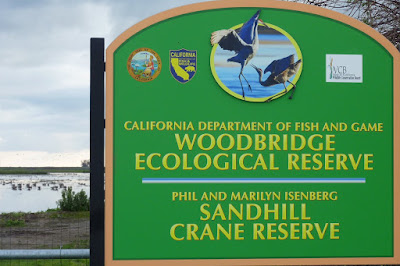Earlier this week Dwight, Tanis, Shasta and I drove to Lodi: over and on levies, across bridges that rise to allow ships to navigate the Sacramento River from the Oakland Port to the Sacramento Port, along wetlands, some just recently restored and near Grizzly Island Wildlife Area where a reestablishing elk herd resides. Once settled into the Lodi Motel 6 after a brief rest, we joined 27 others for a free 90+ minute tour offered by the California Department of Fish and Wildlife at the Woodbridge Ecological Reserve.
We all were there to hear about and see the Sandhill Cranes, both Lesser and Greater. Check out this Aldo Leopold link to see the multiple migration paths of various flocks of cranes. Of course, the bulk of the cranes overwinter on the Platte River in Nebraska and the population wintering in the Albuquerque Area is extremely small, on the verge of "threatened."
We were not disappointed. These four flew in as the docent was giving her talk. Can you discern the two on the left? I know it looks like there is only one, but there are two. Look closely and you will notice the number of legs.
Also during the talk this very large flock of Greater White-fronted Geese flew in and settled on the water as well.
The talk ended in time for movement of the group to an area where often at sunset the cranes fly in for the night. Again we were not disappointed. The show, better than anything on TV!!!, included thousands of these magnificent birds flying in from all directions in small groups, often as few as two, four, or six, and large groups with many hundreds.
The landings were amazing to watch with the members of each group settling in amongst those already sitting in the several inches of water, often not with those cranes they flew in with. The sounds were almost deafening and sounds one will remember once you have heard their distinctive voices. “A loud, resonant, wooden rattle hkkkkk or hkarrrr, variable;
a rolling bugle, typically a long, slightly descending roll, but with some variation,” according to The Sibley Guide to Birds.
a rolling bugle, typically a long, slightly descending roll, but with some variation,” according to The Sibley Guide to Birds.
On the short drive from where we gathered for the talk, we drove our individual cars allowing participants to stop along the way to view the fields covered with swans and geese; intermingled were a few cranes as well.
 |
| Mostly Tundra Swans although upon close inspection other kinds can be identified as well. |
This particular preserve is under the auspices of the California Department of Fish and Wildlife and has never been farmed; rather it has been owned previously by “duck clubs.” The entire area has many levies with fields for growing corn, nonnatives grasses, wine grapes and mostly almond trees. The corn and grass fields provide food and resting areas for the cranes, geese, and swans. The vineyards and tree orchards do not, which is the reason organizations sensitive to not only the survival but thriving of other BEings are forming “trusts” to preserve these feeding grounds. In the early Fall along with the adults the 3 month old crane juveniles arrive to feed and grow into young adults before returning to their Northern nesting areas.
The following day, once Shasta had her walk albeit not as long as she would have liked, we had breakfast, packed up and checked out and drove to the Cosumnes River Preserve. Unfortunately Shasta had to stay in the car since “no pets” are allowed on any of the nature trails. There is a sweet, small visitors center filled with information about the flora and fauna of the area. Along the top of the deck railing is a wonderful depiction of the seasonal changes of both the flora and fauna with such information as when the Swainson’s Hawk leaves for its migration to Argentina.
The short Boardwalk Trail and Tanis’s spotting scope allowed all of us fabulous views of the birds gamboling about in the wetlands, both in the water and on spits of land.
 |
| A Great Egret surveying the wetlands' landscape for food. |
 |
| What a stunning pair of Northern Pintail ducks. The male in his tuxedo like attire looks sleek and ever so handsome. The female is quite lovely in her soft, brown silk like gown. |
Lunchtime arrived so we traveled just a few miles to Locke, the Chinese settlement, and now part of the State Park system, finding a picnic table on which to enjoy our lunch we brought. A local stopped by to add a bit of information about the settlement, both historical and present day. The locals are against tunneling the water from the Delta down to thirsty Los Angeles . . . duh!
 |
| Notice the picnic table on the other side of the wooden white fence? That is were we enjoyed our lunch in the warm sunshine. |
 |
| All three of us noticed the clothes hung out to dry, demonstrating that, yes, someone still lives in this village. |
Then we drove in a circle since all three of us missed the sign for the appropriate turn for our return to Sonoma County. As we recognized several draw bridges and finally arrived in Rio Vista, we all had a good





No comments:
Post a Comment